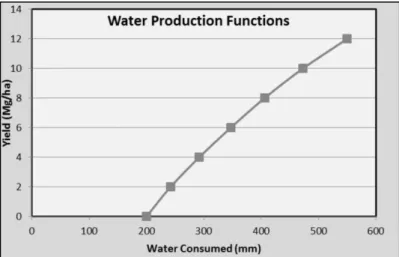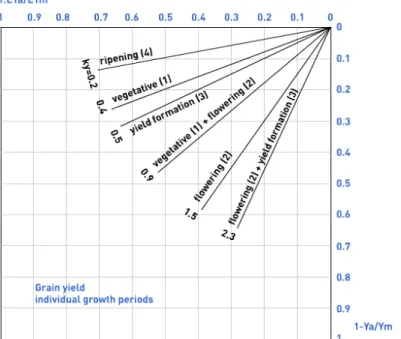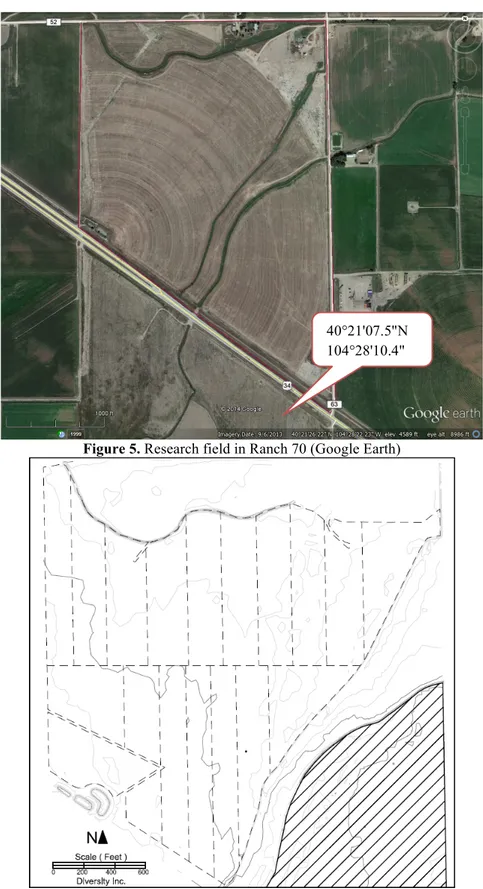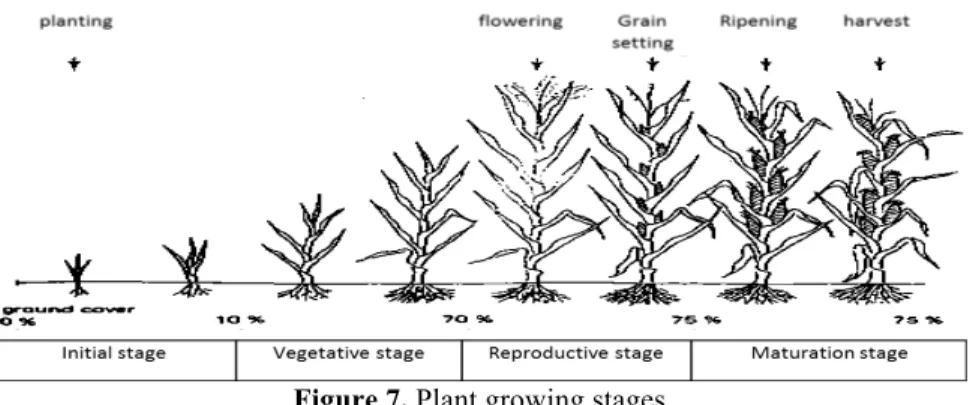A Strategy to Conserve Agricultural Water Use in Colorado’s Front
Range
Manijeh Mahmoudzadeh Varzi and Ramchand Oad
Department of Civil and Environmental Engineering, Colorado State University
Abstract. For the joint sustainability of agriculture and other economic sectors, agriculture water use will need to become more efficient and productive in the future. And, indeed, there are opportunities in the agriculture sector for water conservation by utilizing modern technology such as the drip irrigation and the practice of deficit irrigation. A collaborative research effort will be undertaken by the United Water and Sanitation District, the Platte River Water Development Authority, the 70 Ranch, Netafim, and the Colorado State University. The overall goal of the collaborative research is to generate knowledge for preserving the strong agricultural economy of the South Platte Valley in Eastern Colorado, while at the same time freeing up some water for other societal needs. This will be done by establishing a research/extension station in the region and conducting experimentation on more efficient irrigation technologies such as subsurface drip irrigation and deficit irrigation. The underlying premise is that by following such crop and water management practices, the farmers can increase their net economic returns. The planning horizon to achieve this long-term goal is about 15-20 years, but some practical answers to specific research questions should be available in early phases. This document briefly discusses a research proposal focused on the initial stage of the above study (first two years). The aim is to examine: (a) the feasibility of drip irrigation and (b) the effect of deficit irrigation on some of the drought resistant local crops in order to define the feasibility of deficit irrigation for farmers. Field work and data collection starts on summer 2015.
1. Problem Statement
Water is the life blood of economy in arid Western United States. Currently
available fresh water supplies are very limited and fully appropriated among existing water demands. In Colorado’s Front Range region, demand for water has increased at a very fast pace especially because of rapid urban growth and newly developing gas and oil industry. Urban communities buy water rights from farmers to satisfy their growing demands, thereby leaving the agricultural land without water; the practice which is locally called “buy and dry”.
A better alternative to the practice of drying up productive agricultural lands could be to explore the option of water conservation by utilizing modern technology such as drip irrigation and the practice of deficit irrigation (Prior et al. 2013). An efficient and
productive irrigation water use in agriculture sector can free up significant amount of water that can be productively utilized for other societal needs.
In this research, a combination of subsurface drip irrigation and deficit irrigation is suggested to reduce agricultural water demands without reducing its profitability.
The study area includes the entire South Platte River Valley stretching from the northern metro Denver area to the Nebraska border (See Figure 1). The South Platte Basin is approximately 22,000 square miles (NWS data 2014) with a population of 3.5 million and 830,000 acres irrigated land (CDM Smith 2013) making 24 percent of Colorado’s irrigated
Figure 1. South Platte River Basin (map made with NWS data)
2. Research Objectives and Questions
The overall objective of the proposed research is to generate knowledge for
preserving the strong agricultural economy of the South Platte Valley in Eastern Colorado, while at the same time freeing up some water for other societal needs.
The first phase will focus on investigating the feasibility of drip irrigation and deficit irrigation as strategies to reduce agricultural water use in the South Platte River Valley of Colorado. This will be done by establishing a research/extension station in the region and conducting experiments on relatively more efficient irrigation water
management technologies including subsurface drip irrigation and deficit irrigation. In line with experimentation the institutional structure of water allocation in Colorado will be studied to define methods and opportunities for transferring water from agriculture to other uses, either temporarily or permanently. The specific research questions are:
1. What is the effect of severity of deficit irrigation on crop yield for selected local crops?
a. Develop crop production functions for selected crops, which relates crop yield to water consumed by crop (Figure 2).
b. Determine crop water use efficiency and irrigation water use efficiency c. suggest crops that can adapt to deficit irrigation
2. Would farmers be able to make informed decisions related to the economically feasible level of deficit irrigation?
a. Carry out cost-benefit analysis for different deficit levels applied b. Develop a Decision Support System (DSS) to optimally allocate water
3. Concepts and Definitions
Crop water requirement (WR) is the maximum amount of water that crop can
use productively when the soil water content is not limiting. Crops mainly need water for cooling purposes; most of root’s water uptake is released back to the atmosphere through evapotranspiration and only a negligible fraction is retained for crop growth (Schneekloth and Andales 2009). Therefore “crop evapotranspiration” and “crop water requirement” are used interchangeably. Evapotranspiration (ET) is the combination of two separate
processes whereby water is lost from the soil surface by evaporation and from the crop by transpiration (Allen et al 2006). In this research ET will be calculated according to the method given in FAO irrigation and drainage paper no. 56 (Allen et al 2006).
Crop production function relates crop yield to water consumed by crop (Figure
2).
Figure 2.Crop Water Production Function (adapted from Trout 2014)
Doorenbos and Kassam (1979) have introduced a yield response factor (Ky) in FAO Irrigation and Drainage paper no. 33 and have related yield and evapotranspiration through the following equation,
1 − !!
!! = Ky(1 −
!"!
!"!) (1)
where,
Ya is the actual yield corresponding to actual evapotranspiration (ETa), and Ym is the maximum yield corresponding to maximum evapotranspiration (ETm) so that,
1 − !!
!! is the relative crop yield decrease and 1 − !"!
!"! is the relative evapotranspiration deficit.
flowering, yield formation, and ripening). The higher the Ky, the greater is the reduction of yield for a given reduction in ET. For this research we will define crop yield reduction by experiment and will not use the above Equation.
Figure 3.Relationship between relative yield decrease Ya/Ym) and relative evapotranspiration deficit (1-ETa/ETm) for maize; for total growing period Ky=1.25 (Doorenbos and Kassam 1979, p.103)
Crop water use efficiency (WUE) is the ratio of economic yield to
evapotranspiration (Tolk and Howell 2003).
Irrigation water use efficiency (IWUE) is the ratio of economic yield to irrigation
water applied. This index is used to characterize crop yield in relation to total water applied for irrigation (Irmak et al 2011).
Deficit irrigation is “the deliberate under-irrigation of the crop” (English 1990); it
is an on-farm strategy to cope with water scarcity. Crop yield increases with more irrigation. This increase is a linear function up to about 50% of crop water requirement (English et al. 2002, Raes et al. 2006). After this point the increase in crop yield declines and takes a curvilinear shape (Figure 4).
Subsurface drip irrigation (SDI) is defined by ASABE (2007) as “application of
water below the soil surface through emitters, with discharge rates generally in the same range as drip irrigation.” They define the common discharge for drip irrigation lower than 8 liters/hour (L/hr) for single emitters and 12 L/hr for line-source emitters. Camp (1998) in his review of articles related to SDI concludes that this irrigation system “provides a more efficient delivery system” when application is matched to crop water and nutrient requirements.
The primary reason for choosing SDI for this research is its great ability to
SDI as a tool for stabilizing yield when applying deficit irrigation. They assert that SDI can allow greater economic return when deficit irrigation is necessitated by institutional and hydrological constraints.
Figure 4.General form of crop production function or yield response to water (adapted from English 1990)
4. Methods
Research field: A 140-acre farm located in the service area of the United Water
and Sanitation District (UWSD) in northeast Colorado is dedicated to this research. It is located at the intersection of HW 34 and CR 63 (Figure 5) and represents the local
conditions in terms of soil type and the crops grown (winter wheat, summer corn and other fodder crops). The nearest town is Kersey.
The research farm will be divided into 18 parcels of about 5 acres as shown in Figure 6. The parcel size is larger than conventional research plots and closer to farming plot size in the area (5 to 10 acres). The crop grown in each parcel will be subjected to a certain level of water stress through deficit irrigation. The field will be equipped with subsurface drip irrigation system from Netafim and deficit irrigation will be examined on local crops.
Sorghum has been selected for the first year experimentation. For later years the research crops will be chosen based on:
a. Common crops in Weld County, given in Table 1. b. Farmers’ opinion, using a questionnaire
Table 1. Common agricultural crops of Weld County in 2013 (Source: CAS 2014)
Crop Planted Harvested Yield Production
(acres) (acres) (tons/acre) (tones)
Winter wheat 134,500 126,300 32 4,047,000 Corn 107,500 65,700 162.2 10,659 Sugar Beets 9,800 9,410 33.4 314,000 Alfalfa -‐ 58,000 3.8 221,000 Other Hay -‐ 61,000 2.45 150,800 80% o f C ro p Co ns um pt iv e Us e To ta l C ro p Co ns um pt iv e U se
Water Consumed by Crop (irrigation + rainfall)
Cr op Ha rv es te d Yi el d 50% o f C ro p Co ns um pt ive U se
Figure 5. Research field in Ranch 70 (Google Earth)
Figure 6. Layout of eighteen treatments 40°21'07.5"N 104°28'10.4" W
Stress levels: Different levels of deficit irrigation that will be tested in this research
are chosen according to these considerations:
a. Research (Lamm 1995, English and Raja 1996, Lamm 2003, Trout 2012) shows
crop yield will not reduce for a deficit of 20% or when 80% of crop water requirement is satisfied.
b. Long term average precipitation for Kersey (CoAgMet weather station) shows 25% of crop water requirement is provided by precipitation. So any deficit level below this is only achievable during very dry years.
c. Research (Gerik et al 1998, Tolk and Howell 2003, Payero et al 2005, Shaner 2012) shows water stress during initial and reproductive stages of crop development reduces yield regardless of water applied during vegetative or maturation stage (for plant growing stages see Figure 7). So the crop will not be stressed during those stages.
Figure 7. Plant growing stages
With above considerations in mind the treatments are planned as listed in Table 2. These are applied water as the percentage of “crop water requirement” or ET, when soil water is not limiting. They are the anticipated target levels, but achieving them in actual practice, especially the lower levels, will depend on the amount of rainfall.
Table 2. Target total applied water (irrigation + precipitation) as percentage of crop consumptive use
Treatment Crop Development Stage
Initial and Reproductive Vegetative and Maturation
1 100% 100%
2 100% 70%
3 100% 50%
4 100% 30%
Soil water measurements: Soil water will be measured at two levels:
a. Root zone soil water content; to assure the deficit levels in Table 2 are maintained. Proposed sensor is Decagon EC-5 moisture sensor.
b. Groundwater levels; to ensure there is no contribution from groundwater to the root zone. This is necessary because the research field is in Box Elder Creek’s flood zone. The proposed sensor is HOBO Water Level Logger.
5. Expected Results
§ In general, we expect our research results to evaluate models and methods that use limited water resources efficiently to maintain economically viable deficit irrigated and dry-land agricultural production systems.
§ Effects of irrigation timing and total water application on water use efficiency and crop yields will be compared among different deficit irrigation scheduling methods. Crop production functions (water applied vs. crop yield) will be developed for locally grown crops to help farmers select the level of deficit irrigation that economically benefits them.
§ From such results, net knowledge gained is the level and timing of water stress that optimizes the cost and benefits of total operation (agricultural production plus revenues gained from alternate use of saved water).
§ With these data we can investigate the effect of subsurface irrigation system and compare it with conventional irrigation system in the area (center pivot etc.) § Climate analyses will be conducted to develop informational web sites to inform
agricultural producers of recent climate trends and potential impacts on future agricultural productivity. This multifaceted research program will provide the knowledge base for optimizing the use of scarce water resources in arid and semi-arid regions where ground water resources are being depleted.
References
Allen R. G., and L. S. Pereira, D. Raes, and M. Smith 2006: Crop Evapotranspiration (guidelines for computing crop water requirements). FAO irrigation and drainage paper No. 56. ASAE Standards 2007: Soil and Water Terminology. S526.3 SEP2007.
FEMA 2015 accessed from: https://msc.fema.gov/portal/advanceSearch.
Camp C. R. 1998: Subsurface Drip Irrigation: A Review. Transactions of the ASAE, 41, 1353-1367
1998.
CAS (Colorado Agricultural Statistics) 2014: National Agricultural Statistics Service. Colorado Field Office,
USDA NASS Mountain Regional Office.
CDM Smith 2013. South Platte Decision Support System Alluvial Groundwater Model Report. The
Colorado Water Conservation Board and Colorado Division of Water Resources.
CoAgMet 2014 Colorado Agricultural Meteorological Network, accessible at: www.coagmet.com Doorenbos, J. and A.H. Kasssam, 1979: Yield response to Water. FAO Irrigation and Drainage
Paper No. 33.
English M. 1990. Deficit Irrigation. I: Analytical Framework. J Irrigation and Drainage Engineering, 116,
399-412.
English, M. J., and S. N. Raja, 1996: Perspectives on deficit irriga tion. Agricultural Water
Management, 32, 1–14.
English, M. J., K. H. Solomon, and G. J. Hoffman 2002: A Paradigm Shift in Irrigation Management. J
irrigation and drainage engineering september/october 2002, 267-277.
Gerik, T., B. Bean, R. Venderlip 1998: Sorghum Growth and development. Texas A&M University.
Dept. Soil and Crop Sciences B-6137. SCS-1998-29.
Irmak, S., L. O. Odhiambo, W. L. Kranz, and D. E. Eisenhauer 2011: Irrigation Efficiency and Uniformity, and Crop Water Use Efficiency. University of Nebraska Lincoln, Extension.
Lamm, F. R., H. L. Manges, L. R. Stone, A. H. Khan, D. H. Rogers 1995: Water Requirement of Subsurface Drip-Irrigated Corn in Northewest Kansas. Transactions of ASAE, 38, 441-44.
Lamm, F. R. and T. P. Trooien 2003: Subsurface drip irrigation for corn production: a review of 10 years of research in Kansas. Irrigation Science, 22, 195–200.
Lamm, F. R., Bordovsky J. P., Schwankl L. J., Grabow G. L., Enciso-Medina J., Peters R. T., Colaizzi P. D., Trooien T. P., Porter D. O. 2012: Subsurface Drip Irrigation: Status of the Technology in 2010.
American Society of Agricultural and Biological Engineers ISSN 2151-0032.
NWS 2014. “National Weather Service data for South Platte Basin map.” accessible at http://www.nws.noaa.gov/geodata/catalog/national/html/us_state.htm, last accessed on 11/12/2014.
Payero, J. O., Melvin S. R., and Irmak S. 2005: Response of Soybean to Deficit Irrigation in the Semi-Arid Environment of West-Central Nebraska. Transactions of the ASAE, 48, 2189−2203. Prior, A., R. Oad and K. Kinzli, 2013: “Agricultural Water Conservation in the High Plains Aquifer
and Arikaree River Basin.” J Water Resource and Protection, 5, 747-759.
Raes, D., S. Geerts, E. Kipkorir, J. Wellens, A. Sahli 2006: Simulation of yield decline as a result of water stress with a robust soil water balance model. Agricultural Water Management, 81, 335–357.
Schneekloth, J. and A. Andales 2009: Seasonal Water Needs and Opportunities for Limited Irrigation for Colorado Crops.” Colorado State University Extension. 4/03. Revised 9/09. Shaner, D. 2012: Management strategies to sustain irrigated agriculture with limited water supplies,
project plan (NP 211 Water Availability and Water Management).
Tolk, J. A. and T. A. Howell 2003: Water use efficiencies of grain sorghum grown in three USA Sothern Great Plains soils. Agricultural Water Management, 59, 97-111.
Trout T. J. 2012: Water Production Functions for Central Plains Crops. Proceedings of the 24th Annual
Central Plains Irrigation Conference, Colby, Kansas, February 21-22 USDA-ARS-Water Management Research.
Trout T. 2014: Can Deficit Irrigation Help Sustain Colorado Irrigated Agriculture? Colorado Water Institute





